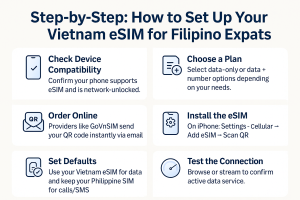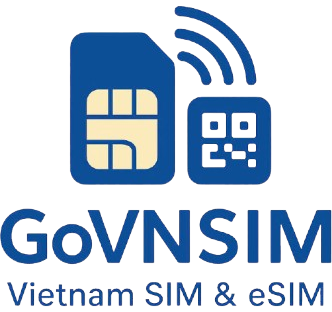🇻🇳📶 Vietnam eSIM for Filipino Expats – Stay Connected Seamlessly in 2025
Vietnam eSIM for Filipino expats is one of the most convenient connectivity solutions for those living and working in Vietnam. Whether you are based in Ho Chi Minh City, Hanoi, Da Nang, or emerging hubs like Binh Duong and Bac Ninh, having a reliable internet connection is essential for daily life—video calls with family in the Philippines, remote work, banking, ride‑hailing, and navigation. This guide keeps the original structure but adds friendly icons to make scanning easier while preserving every SEO element you asked for.
✨ Why Filipino Expats in Vietnam Prefer eSIM
- No physical SIM swap – Keep your Philippine SIM (Globe/Smart) active for OTP and calls while using Vietnam eSIM for data.
- Instant activation – Plans can be purchased and activated online before or after arrival; QR delivery is immediate.
- Better rates – Local eSIMs deliver far cheaper data than international roaming from home carriers.
- Stable coverage – Viettel, MobiFone, and Vinaphone cover most of Vietnam, including many rural and industrial zones.
- Multi‑device convenience – Dual‑SIM phones, tablets, and some wearables support eSIM for flexible setups.
📡 Top eSIM Providers in Vietnam for Filipino Expats
While there are multiple options, three major carriers dominate the market. Here is a quick view that Filipino professionals, teachers, OFWs, and long‑stay residents typically compare:
| Provider | Coverage | Data Speed | Filipino‑Friendly Notes |
|---|---|---|---|
| Viettel | Nationwide, strong in rural/industrial areas | 4G/5G where available | Excellent for work assignments and intercity travel |
| MobiFone | Urban + suburban | 4G | Some plans include a local number for SMS apps |
| Vinaphone | Urban‑focused, decent tourist corridors | 4G | Often competitive on short‑term validity |
💰 Cost Overview – 2025
As of 2025, these are common price bands for local Vietnam eSIM plans that Filipino expats choose for everyday use:
-
7–10 GB / 30 days – 350,000VND
($13.5) ≈ ₱770 -
15–25 GB / 30 days – ~550,000–650,000 VND ($22–$26.7) ≈ ₱1,280–₱1,510
-
“Unlimited” day plans (FUP after a threshold) – ~700,000–900,000 VND ($28–$36.9) ≈ ₱1,630–₱2,100
These totals typically undercut Philippine roaming packages, which can cost ₱500–₱1,000 for just a few days of light data. For long‑stay expats, the savings add up quickly over a year.
📱 Device Compatibility
Most modern phones used by Filipino expats support eSIM. Check that your device is factory unlocked or network‑unlocked by your home carrier before installation.
- Apple: iPhone XR and newer (including SE 3rd gen)
- Samsung: Galaxy S20+, Note 20+, Flip/Fold families
- Huawei: P40+, Mate 40+ (where supported)
- Google: Pixel 4 and newer
🧭 Daily Life with Vietnam eSIM for a Filipino Expat
Maria, a marketing manager from Cebu working in Hanoi, switched to a 30‑day Viettel eSIM from GoVnSIM. She activated it in under five minutes upon arrival. With 25 GB per month she handled Zoom meetings, cloud files, and WhatsApp video calls to her parents in the Philippines. Weekend trips to Sapa, Ninh Binh, and Ha Long Bay were smooth thanks to stable coverage. She kept her Globe SIM active for OTP and incoming calls, avoiding the hassle of SIM swaps and keeping expenses predictable.
🪪 Requirements & Good‑to‑Know
- Unlocked phone – The single most important prerequisite.
- Stable Wi‑Fi for installation – Installation is fastest over reliable Wi‑Fi.
- Dual‑SIM settings – Decide which line handles mobile data, calls, and SMS.
- Roaming toggles – Some devices require enabling “Data Roaming” on the eSIM profile even when you are inside Vietnam.
🧩 Vietnam eSIM vs Philippine Roaming
| Feature | Vietnam eSIM | Philippine Roaming |
|---|---|---|
| Cost | ₱450–₱1100 / month (typical) | ₱600–₱1300 / week (often) |
| Activation | Instant QR scan | Carrier portal/app; may require support |
| Data Speed | Local 4G/5G where available | May be throttled; roaming latency higher |
| Flexibility | Switch plans anytime | Tied to home‑carrier offers |
🗺️ Best Areas for Stable Coverage
Viettel is often favored for broad reach, including highways and developing industrial zones. MobiFone and Vinaphone are strong in major cities and tourist corridors. Filipino expats frequently report reliable service in:
- Hanoi and nearby provinces (Bac Ninh, Hung Yen, Vinh Phuc)
- Ho Chi Minh City, Binh Duong, Dong Nai, Vung Tau
- Da Nang, Hoi An, Hue
- Nha Trang, Phan Thiet/Mui Ne
- Hai Phong, Quang Ninh (Ha Long), Sapa/Lao Cai
🛡️ Security & Privacy Considerations
When using Vietnam eSIM for Filipino expats, purchase from reputable providers. Avoid unknown Wi‑Fi networks without a VPN, keep OS and apps updated, and beware of phishing SMS or messages demanding top‑ups. If you need a Vietnam phone number for services like Grab or receiving local calls, choose plans that explicitly include voice/SMS. Note: Viettel eSIM sold by GoVnSIM is data‑only (no Vietnam phone number, no OTP support). For a local number, consider suitable alternatives (e.g., MobiFone with number) depending on your use case.
🧰 Tips for Filipino Expats Using eSIM in Vietnam
- Keep both SIMs active – Use dual‑SIM so your Philippine number remains reachable while your Vietnam eSIM provides data.
- Top up online – Many providers allow app‑based or website top‑ups; save your receipts for work reimbursement.
- Set data warnings – Configure data usage alerts to avoid FUP slowdowns.
- Use messaging first – Messenger, Viber, WhatsApp, and Telegram are reliable for cross‑border communication.
- Test in multiple spots – If speeds dip at home, try by a window or different room to improve signal.
🧾 Step‑by‑Step: How to Set Up Your Vietnam eSIM for Filipino Expats

- Check Device Compatibility – Confirm your phone supports eSIM and is network‑unlocked.
- Choose a Plan – Select data‑only or data + number options depending on your needs.
- Order Online – Providers like GoVnSIM Shop send your QR code instantly via email.
- Install the eSIM – On iPhone: Settings → Cellular → Add eSIM → Scan QR. On Android: Settings → SIM Manager → Add eSIM.
- Set Defaults – Use your Vietnam eSIM for mobile data and keep your Philippine SIM for calls/SMS.
- Test the Connection – Browse or stream to confirm active data service.
🧪 Optional: How to Run a Quick Speed & Stability Check
- Toggle Airplane Mode for 10 seconds, then off, to refresh radio registration.
- Lock to 4G/5G Auto where available; avoid 3G fallback unless necessary.
- Close heavy background sync (cloud photo backup) before testing.
- Use a reputable speed test app and run 2–3 samples at different times of day.
🧑🏽💼 Common Questions from Filipino Expats
📞 Can I keep my Philippine number active while using Vietnam eSIM?
Yes. With dual‑SIM, keep your Globe or Smart SIM for calls and OTP while the Vietnam eSIM supplies data. This is the preferred setup for many long‑stay expats.
🛫 Can I install eSIM before flying to Vietnam?
Yes. Many providers allow pre‑activation so you have internet immediately upon landing, making it easier to arrange airport rides or message landlords.
🔄 What if I change phones?
eSIM profiles are generally not transferable between devices. You will need a fresh QR code from your provider—contact support before switching.
🧍🏽♀️ Is eSIM good for families or shared hotspots?
Yes. Many Filipino families in Vietnam use one plan per adult and share data with children via mobile hotspot. For critical calls (Zoom/Meet), USB tethering from a laptop can be more stable than Wi‑Fi hotspot.
🧭 Practical Use Cases for Filipino Expats
- Education & teaching – Stable connectivity for lesson prep, LMS access, and parent communication.
- Manufacturing & engineering – Coverage in industrial parks for cloud emails, CAD reviews, and site navigation.
- BPO/remote work – Low latency to regional servers improves call quality and productivity.
- Daily living – Grab, Google Maps, food delivery, banking, and e‑commerce apps function smoothly with a local data line.
🧩 Choosing Between Data‑Only vs Number‑Included Plans
Filipino expats who already keep their PH SIM active often pick data‑only eSIMs for simplicity and cost‑efficiency. If you require a local number for calls/SMS verification inside Vietnam, choose a plan that explicitly includes a Vietnam number (for example, certain MobiFone options). Remember: Viettel eSIM sold by GoVnSIM is data‑only and does not support OTP.
🧯 Troubleshooting Basics
- No data after installation – Reboot, ensure the eSIM line is enabled for mobile data, and toggle Data Roaming on that profile.
- Slow speeds – Move to an open area, lock to 4G/5G Auto, or test at a different time to avoid congestion.
- QR not scanning – Increase screen brightness, or enter activation details manually if provided by the seller.
- Accidental deletion – Contact your provider for a replacement QR (policies vary).
✅
For long‑stay residents from the Philippines, the Vietnam eSIM delivers convenience, savings, and flexibility. Whether you are a teacher in Ho Chi Minh City, an engineer in Da Nang, or a freelancer in Hanoi, you gain fast local data without losing access to your Philippine number. Choose a reputable provider, install over Wi‑Fi, set the right defaults, and you will enjoy seamless everyday connectivity in Vietnam while keeping close to family and work back home.
📌 Need a reliable Vietnam eSIM plan? Order from GoVnSIM for instant QR delivery and coverage across Vietnam. Learn more about the technology on eSIM (Wikipedia).
